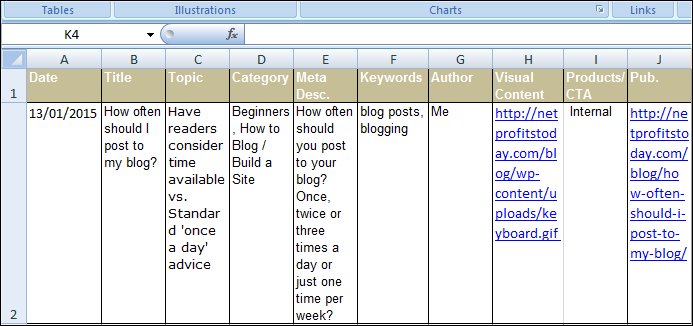Last week I was one day late sending out a notice via Aweber to my email subscribers of the last article I'd posted to the blog.
UGH.
That was especially UGH after I'd written, “The Best Day of the Week to Send Email“, only two weeks before.
I have no excuse other than I started writing “21 Types of Blog Posts” on Monday, and then got side-tracked by more important matters. (Yes, it's true! I have a teeny weeny bit of a life beyond blogging, and sometimes that life gets in the way. 🙂 )
So, back to basics for yours truly, i.e. planning content well in advance.
Here are some things to consider when you create your content plan:
- Know how often you are able and willing to post new/original content to your blog.
- Can you perhaps ‘beef up' your content delivery with a weekly round-up of other's posts?
- Does your niche lend itself to content that is naturally structured over the year, i.e. gardening, fishing, camping, snowbirding, etc.?
- How do holidays affect your content schedule? For example, if you are in the dating niche, Valentine's Day will be of great importance.
- Can you develop a monthly (or other timeline) theme that works with your niche? For example, Astrology works well into a calendar.
- Are you planning a series of posts at some point during the year? Figure out when that series will be most welcomed by your readers. Every niche audience has its break times… make sure you understand your audiences needs and wants.
- Perhaps you'd like to do a series of webinars, podcasts or videos. Schedule these into your calendar in a way that works for you and your audience.
- Do you allow guest posts on your blog? Decide how often guest authors can post and schedule them into your timeline.
- Last but certainly not least, consider your goals. Do you want to increase your online presence by building your readership through newsletter signups and social media or increase sales of your products, or both? Plan your post deliveries for a 3 to 1 between acquiring signups and actively endorsing products(25% ratio of selling vs. information) if you want to keep your readers loyal.
With those considerations in mind, you might want to use an editorial calendar in order to follow a plan, rather than sitting down at your computer each week on ‘content delivery day' and wonder what the heck you're going to write about.
Here's a screenshot of the Excel editorial calendar I use.

The columns are labelled as follows:
- Date (planned Publication Date)
- Title
- Topic Category
- Meta Description
- Keywords
- Author
- Visual Content (Graphics Links)
- Products/CTA
- Pub. (actual Publication Date)
I've noticed that other bloggers create much fancier schedules with Excel, while others use online planning tools such as Evernote and Google Keep.
Use whichever system makes the most sense to you. I personally prefer having a spreadsheet on my desktop, as opposed to yet another online account.
Once you've created your editorial calendar, check it regularly to make sure you are following the plan, and/or to make changes as required — for when life gets ‘in the way'.
Comments, questions or suggestions? Please leave a comment below!
Cheers,

 Now that you know how to come up with endless
Now that you know how to come up with endless  Show your readers who you really are. Tell them about a day in your life, your perspective on a particular event or how your dog helps with your blogging. Yes, that is my blogging dog, Jasper. He has his own
Show your readers who you really are. Tell them about a day in your life, your perspective on a particular event or how your dog helps with your blogging. Yes, that is my blogging dog, Jasper. He has his own